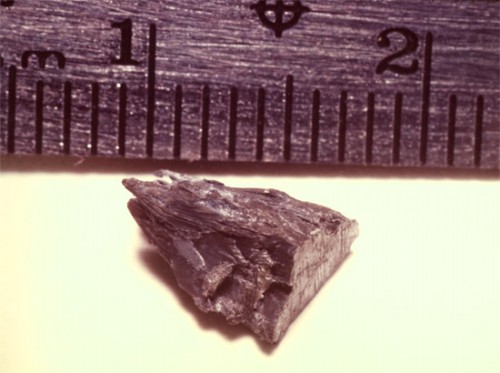Date:
1957
Location: Ubatuba, Sao Paulo, Brazil
On
September 14, 1957, Ibrahim Sued, a columnist for the
Rio de Janeiro newspaper O Globo, printed a letter which
he had received, concerning a UFO incident. Accompanying
the letter were three small pieces of white metal. The
writer of the letter described an event in which a "flying
disk" exploded over the beach at Ubatuba, in Sao
Paulo Province. One of the samples was analyzed and the
results showed a 99.99% pure magnesium.

One of the Ubatuba fragments.
Source:
Billy Booth, About.com
Summary:
On September 14, 1957, Ibrahim Sued, a columnist for the
Rio de Janeiro newspaper O Globo, printed a letter which
he had received, concerning a UFO incident. Accompanying
the letter were three small pieces of white metal. Thus
was ushered in one of the most controversial of all physical-evidence
cases. The writer of the letter described an event in
which a "flying disk" exploded over the beach
at Ubatuba, in Sao Paulo Province.
"Rained
Down" from Exploding Disc:
Some
of the metal, which had "rained down" from the
exploding disk, was collected, and three small pieces
were included in the letter to Sued. Unfortunately, the
signature on the letter was illegible. Furthermore, the
identity of all witnesses to the original seaside event
at Ubatuba remains unknown, despite extensive searches
by the Brazilian representative of APRO, Dr. Olavo FONTES.
This lack of witnesses is one of the greatest weaknesses
of the Ubatuba case.
Two
Separate Incidents: This piece of metal was picked up
after a UFO explosion over Toninha's Beach, in Ubatuba,
Sao Paula State, Brazil, in 1957. This sample was analyzed
and the results showed a 99.99% pure magnesium. This other
piece fell down from one of the three UFO's that had flown
over the city of Caminas, Sao Paulo State, Brazil, on
December, 1954. Tests proved the material to be 88.91%
pure tin.
Analysis
of Fragments: Mr. Sued gave all three pieces of metal
to Dr. Fontes, who in turn had one of them analyzed at
the Mineral Production Laboratory of the Department of
Mineral Production in the Brazilian Ministry of Agriculture.
Dr. Fontes personally delivered the samples to the chief
chemist, Dr. Fiegl, an internationally known specialist.
A qualitative, acid test was first made on a small chip,
which showed that the fragments were truly metallic.
Only
Magnesium: One of the original fragments, designated Sample
No.1 by Dr. Fontes, was subdivided into several pieces
and two of the pieces were submitted to the Spectrographic
Section of the Mineral Production Laboratory Semi-Quantitative
Emmission Spectrochemical Analysis. One of the pieces
was analyzed by Dr. Luisa Maria A. Barbosa. The analysis
surprisingly revealed that the sample contained only the
element magnesium.
First
Test Validated: A second fragment of Sample No.1 was submitted
to a separate spectrographic analysis by Mr. Elson Teixeira
of the Mineral Production Laboratory. Mr. Teixeira confirmed
Dr. Barbosa's finding that Sample No.1 was pure magnesium.
Further tests were run on fragments of Sample No. 1. These
included Debye-Scherrer-Hull powder pattern X-ray diffraction
analysis, density measurement, and radiation tests.
Not
Made on Earth: The significance of Dr. Barbosa's and Mr.
Teixeira's findings is that it is impossible to produce
any element, terrestrially, that is absolutely spectrographically
pure. These results, therefore, are often cited by proponents
of UFO extraterrestrial existence as proof that the Ubatuba
material must be EXTRATERRESTRIAL. Unfortunately, this
supposition cannot be proven, due to the lack of any further
Sample No.1 fragments for verification analysis.
More
Witnesses Needed: The Ubatuba incident is certainly in
need of futher verification, especially the details of
the UFO incident itself. All we have is the word of one
anonymous person who wrote the letter received by a newspaper.
The case itself is dated by the receipt of the letter,
and not the incident of the crash, so there are no first
hand witnesses to the UFO incident itself.
Source:
http://www.ufoevidence.org/cases/case829.htm
